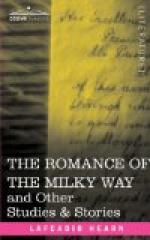* * * * *
To ancient Chinese fancy, the Milky Way was a luminous river,—the River of Heaven,—the Silver Stream. It has been stated by Western writers that Tanabata, the Weaving-Lady, is a star in Lyra; and the Herdsman, her beloved, a star in Aquila, on the opposite side of the galaxy. But it were more correct to say that both are represented, to Far-Eastern imagination, by groups of stars. An old Japanese book puts the matter thus plainly: “Kengy[=u] (the Ox-Leader) is on the west side of the Heavenly River, and is represented by three stars in a row, and looks like a man leading an ox. Shokujo (the Weaving-Lady) is on the east side of the Heavenly River: three stars so placed as to appear like the figure of a woman seated at her loom.... The former presides over all things relating to agriculture; the latter, over all that relates to women’s work.”
* * * * *
In an old book called Zatsuwa-Shin, it is said that these deities were of earthly origin. Once in this world they were man and wife, and lived in China; and the husband was called Ishi, and the wife Hakuy[=o]. They especially and most devoutly reverenced the Moon. Every clear evening, after sundown, they waited with eagerness to see her rise. And when she began to sink towards the horizon, they would climb to the top of a hill near their house, so that they might be able to gaze upon her face as long as possible. Then, when she at last disappeared from view, they would mourn together. At the age of ninety and nine, the wife died; and her spirit rode up to heaven on a magpie, and there became a star. The husband, who was then one hundred and three years old, sought consolation for his bereavement in looking at the Moon and when he welcomed her rising and mourned her setting, it seemed to him as if his wife were still beside him.




